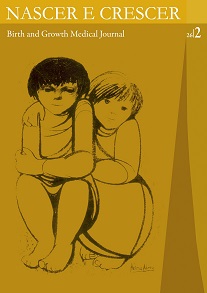Dermatology case
DOI:
https://doi.org/10.25753/BirthGrowthMJ.v26.i2.9768Keywords:
Tuberous sclerosis, Shagreen patch, hypopigmented macules, angiofibromasAbstract
Tuberous sclerosis is an inherited neurocutaneous disorder characterized by pleomorphic features involving many organ systems, including the skin. The diagnosis of tuberous sclerosis is clinical. The most common cutaneous lesions are hypopigmented macules, also known as ash-leaf spots, which are usually elliptic in shape, angiofibromas, which typically involve the malar regions of the face, and shagreen patches, most commonly present over the lower trunk.
In the present case, the patient was referred to the dermatology department due to an atypical lesion with an uncommon location, revealing the importance of a whole body examination in patients with this disease.
Downloads
References
Crino PB, Nathanson KL, Henske EP. The tuberous sclerosis
complex. N Engl J Med 2006;355:1345.
Curatolo P, Bombardieri R, Jozwiak S. Tuberous sclerosis.
Lancet 2008;372:657.
Au KS, Williams AT, Roach ES, et al. Genotype/phenotype
correlation in 325 individuals referred for a diagnosis of tuberous
sclerosis complex in the United States. Genet Med
;9:88.
Lyczkowski DA, Conant KD, Pulsifer MB, et al. Intrafamilial
phenotypic variability in tuberous sclerosis complex. J Child
Neurol 2007;22:1348.
Yates JR, Maclean C, Higgins JN, et al. The Tuberous Sclerosis
Study: presentation, initial assessments and implications
for diagnosis and management. Arch Dis Child
;96:1020.
Aldrich CS, Hong CH, Groves L, et al. Acral lesions in tuberous
sclerosis complex: insights into pathogenesis. J Am
Acad Dermatol 2010;63:244.
Roach ESm Gomez MR, Northrup H. Tuberous sclerosis
complex consensus conference: revised clinical diagnostic
criteria. J Child Neurol 1998;13:624-8.
Leung AK, Robson WL. Tuberous sclerosis complex: a review.
J Pediatr Health Care 2007;21:108-14.
Balestri R, Neri I, Patrizi A, Angileri L, Ricci L, Magnano M.
Analysis of current data on the use of topical rapamycin in
the treatment of facial angiofibromas in tuberous sclerosis
complex. J Eur Acad Dermatol Venereol 2015;29:14-20.
Downloads
Published
How to Cite
Issue
Section
License
Copyright and Authors' Rights
All articles published in Nascer e Crescer - Birth and Growth Medical Journal are Open Access and comply with the requirements of funding agencies or academic institutions. For use by third parties, Nascer e Crescer - Birth and Growth Medical Journal adheres to the terms of the Creative Commons License "Attribution - Non-Commercial Use (CC-BY-NC)".
It is the author's responsibility to obtain permission to reproduce figures, tables, etc. from other publications.
Authors must submit a Conflict of Interest statement and an Authorship Form with the submission of the article. An e-mail will be sent to the corresponding author confirming receipt of the manuscript.
Authors are permitted to make their articles available in repositories at their home institutions, provided that they always indicate where the articles were published and adhere to the terms of the Creative Commons license.


